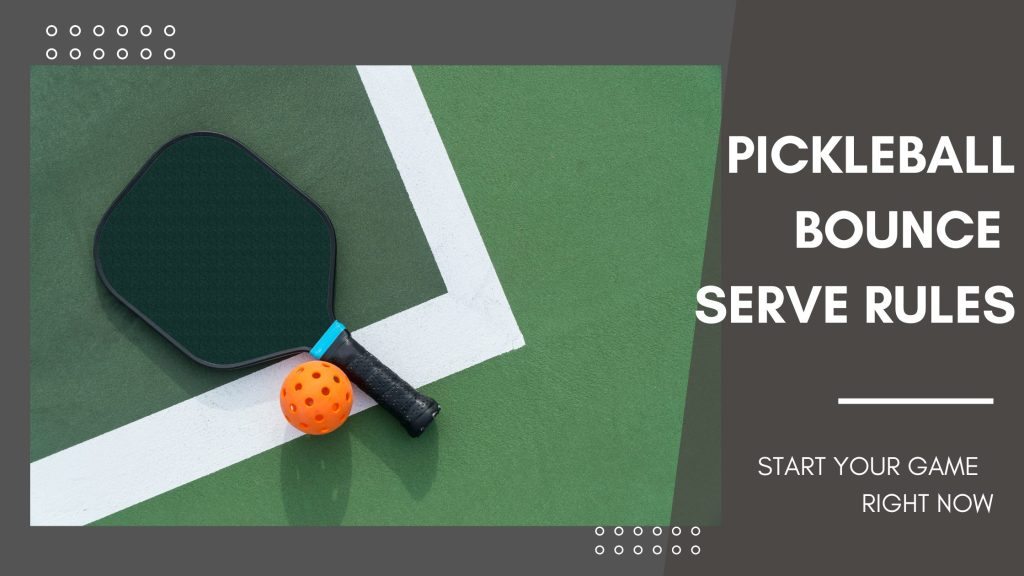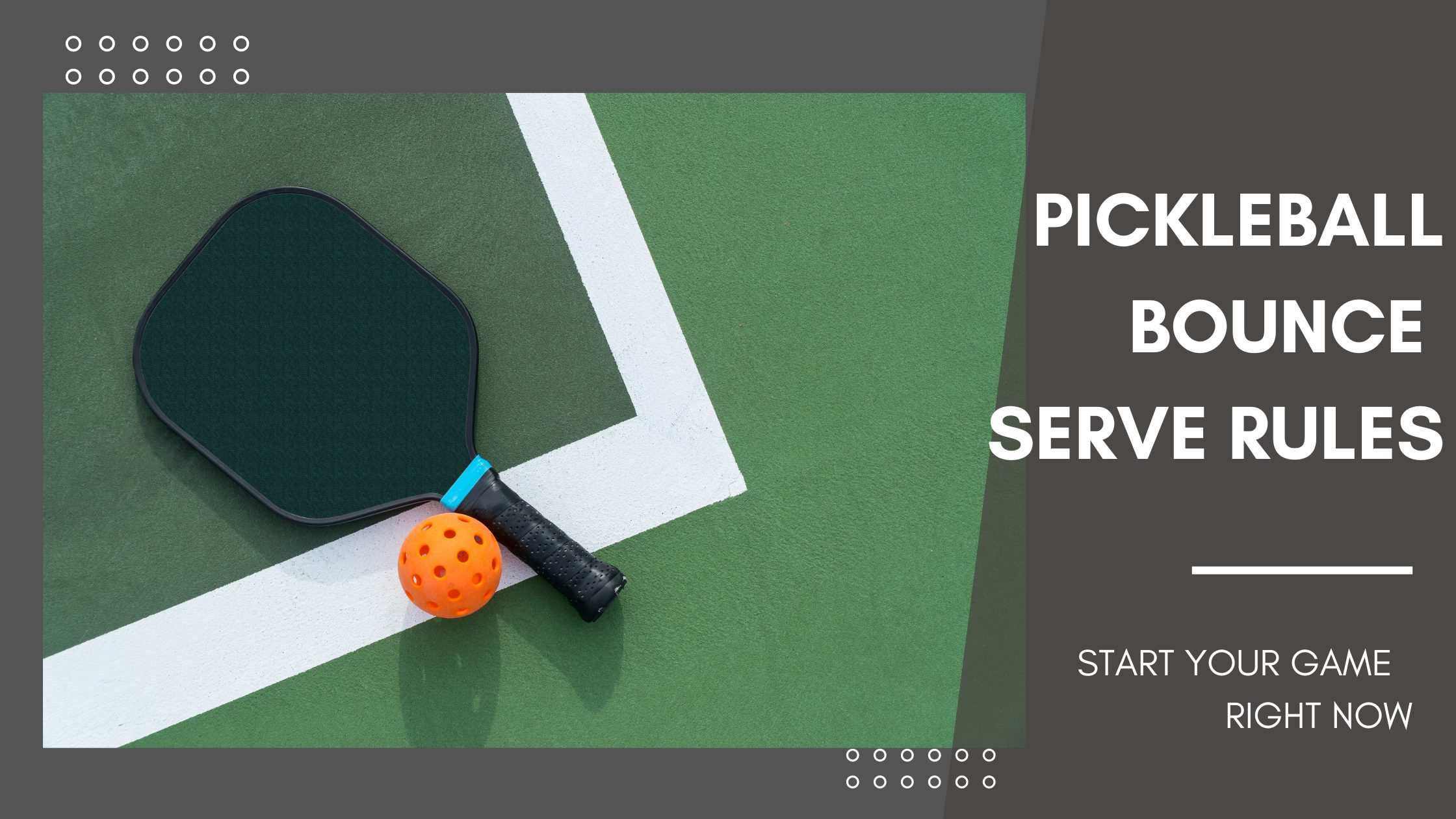The serve in pickleball is an integral part of starting a point. It is the first shot the serving player must make, which can significantly impact how the rest of the point plays out. The objective of the serve is to put the ball in play, so it lands within the opponent’s court. If a player fails to make a good serve, then their opponent will gain an advantage and may easily win the point. Therefore, players must take great care when making their serves; accuracy and power are both key components for success.
In addition, the proper technique should be used when making a serve, as this will ensure that it has enough speed and spin to make it difficult for your opponent to return. The pickleball bounce serve rules are an essential part of pickleball and is necessary for starting a successful point.
Types of Serves inPickleball
Pickleball is a popular racquet sport that combines badminton, tennis, and table tennis elements. There are various types of serves in pickleball which makes the game more interesting and exciting. The most common type is the underhand serve, where the player holds the paddle below waist level and hits it into the opponent’s court. The overhand serve is another type of serve that requires more power, as it involves hitting the ball with an overhead swing.
Advanced players also use reverse pendulum serves as they need greater control to place the ball accurately in the opposing court. Finally, the topspin serve involves a downward motion to generate spin on the ball while sending it to your opponent’s court. All these serves require practice and skill to master and use effectively during games.
What is Pickleball Bounce Serve Rules
As the name might suggest, the pickleball serve rules is a move that involves bouncing the ball off the other side of the court. This serve can be an effective way of making your opponent guess your next move. The bounce serves, when executed correctly, can be a powerful weapon in pickleball.
How to Execute a Bounce Serve
One must first get the ball in the correct position to execute a bounce serve properly. The proper positioning for the shot is with the paddle held above the waist, the arm raised upward, and the shoulder facing forward. The server should then toss the ball across court, so that the ball’s trajectory will arc downward and hit the ground just in front of their opponent. The server should get ready to cover the anticipated return stroke if the ball takes a bad bounce.
The right timing is also essential when executing a bounce serve. The ball should be tossed only after one has a reasonable estimate of the player’s position on the court. When in doubt, the player should wait instead of trying to make a risky toss. Additionally, the serve should be tweaked as the game progresses, with the player making adjustments to their toss to keep it unpredictable for the other player.
Benefits of the Bounce Serve Rule
Tips for Successful Bounce Serve in Pickleball
To perform a successful bounce serve in pickleball, follow these tips.
- Start with the correct stance. Stand with your feet about shoulder-width apart and your weight evenly distributed.
- Hold the paddle in your dominant hand, and keep your arm slightly bent.
- Toss the ball straight up in the air, slightly in front of you.
- Position your feet so you face the opposite side of the court.
- Please keep your eyes on the ball as it comes down and make contact with it at the peak of its bounce.
- Hit the ball upward using an open-face grip on your paddle.
- Follow through with your paddle, keeping your arm and wrist loose.
- Aim for a spot just over the net but close to the back boundary of your opponent’s court.
- Try to hit the ball with topspin, which will help the ball bounce higher on your opponent’s side.
- Use a quick, short swing to generate power and accuracy.
Mistakes to Avoid When Executing a Bounce Serve
Here are some common mistakes to avoid when executing a bounce serve in pickleball:
Avoiding these common mistakes when executing a bounce serve will help you become a better player and improve your pickleball game overall.
The role of the receiver in returning a bounce serve
The receiver in pickleball plays an essential role in returning a bounce serve. Here are some tips for the receiver to keep in mind when returning a bounce serve:
Be equipped to advance
A jump serve may be whacked with a great deal of force and twist, so be ready to move quickly to reach the ball.
Stay balanced
When responding to a server, it is essential to maintain a low and stable stance, which will assist you in reaching the ball quickly and hitting it with more authority.
Observe the ball
Keep your eyes on the ball to observe the spin and speed of the serve, and modify your hit as required.
Select the correct stroke
Depending on the trajectory and position of the serve, you may want to hit a groundstroke, volley, or overhead shot. Pick the shot that will offer you the best chance of getting the ball back into play.
Collaborate with your partner
If you play in doubles, it is vital to collaborate with your partner and decide who will take the serve and where you will be placed on the court.

Strategies for Returning a Bounce Serve Effectively
Move forward towards the net
Moving forward towards the net when returning a bounce serve in pickleball is essential. This will help you get into a better position to hit the ball and make it harder for your opponent to get to it.
Keep your paddle low.
When returning a bounce serve in pickleball, it is essential to keep your paddle low. This will help you return the serve with more control and power.
Aim for the middle of the cour
When returning a bounce serve in pickleball, it is important to aim for the middle of the court. This will help you keep the ball away from your opponent and give you more time to set up your next shot.
Use deep shots
When returning a bounce serve in pickleball, it is essential to use deep shots. This will help you keep your opponent on the defensive and give you more control of the point.
Try to keep the ball in play
When returning a bounce serve in pickleball, keeping the ball in play is essential. This will make it more difficult for your opponent to win the point and give you more time to set up your next move.
Pickleball tips and rules list will make to pro to win your matches.
Common Faults During a Bounce Serve
Here are some common faults and foot faults that can occur during a bounce serve in pickleball:
Foot fault
A foot fault is when the server steps past the baseline or service line while serving. This is an infraction and results in a point for the opponent.
Double bounce
A double bounce fault happens when the ball bounces more times on the server’s side of the court before it is struck. This is a violation and a point is awarded to the receiver.
Short serve
A short serve is when the ball does not bounce within the service box on the other side of the court. This is a fault and gives the receiver a point.
Long serve
A long serve is when the ball does not bounce inside the service box or goes outside the court boundaries. This is a breach and grants the receiver a point.
Illegal serve
An illegal serve is when the serve is aimed at the wrong area of the court or not hit with an underhand motion. This is an infringement and grants the receiver a point.
